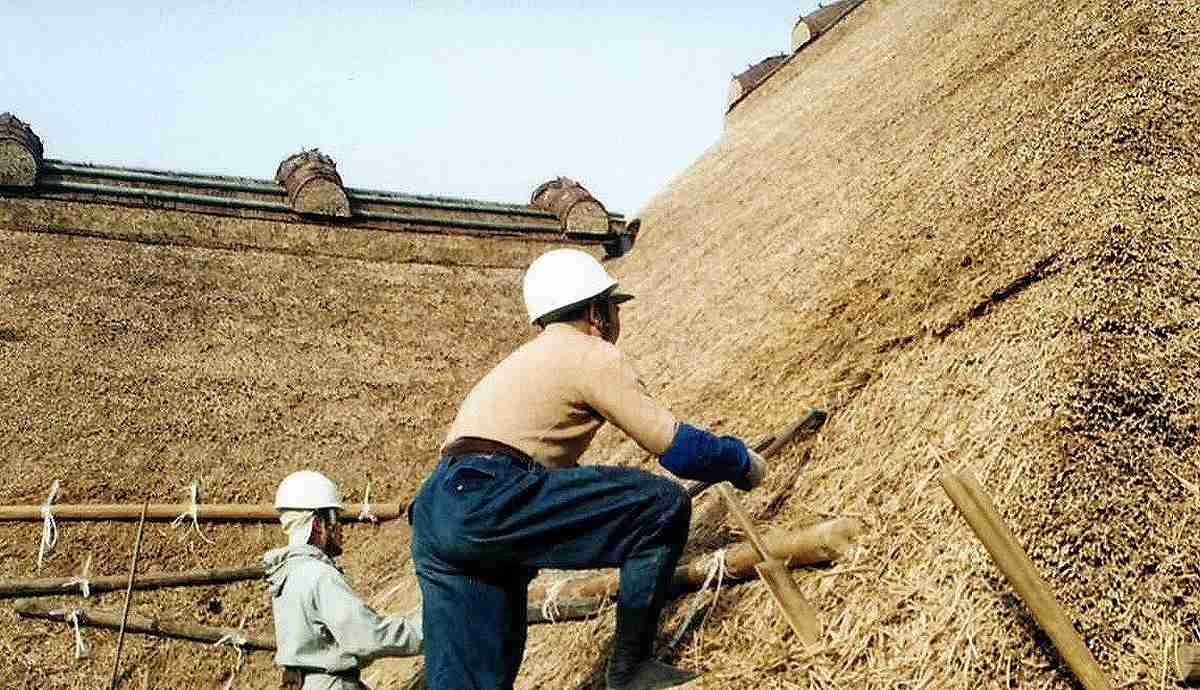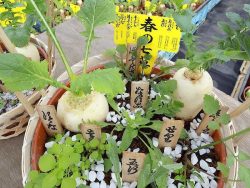Concern Remains about Passing down Traditional Architecture Skills even after UNESCO Registration

Techniques to restore thatched roofs are one of the 17 types of skills that are registered as UNESCO Intangible Cultural Heritage items and are related to the preservation, repair and decoration of the historical wooden structures.
13:43 JST, January 6, 2021
Traditional Japanese craftsmanship used in wooden architecture has been approved for addition to UNESCO’s Intangible Cultural Heritage list by an intergovernmental committee of the Paris-based international body.
The committee approved the registration of “traditional skills, techniques and knowledge for the conservation and transmission of wooden architecture in Japan” at an online meeting last month.
The government and related organizations will try to promote these skills worldwide as something Japan can be proud of. But there are still many tasks to be tackled when it comes to handing down skills and expertise.
■ Sustainable development
The UNESCO registration covers 17 types of skills related to the preservation, repair and decoration of historical wooden structures. These skills have been inherited by 14 preservation groups. The government selected the 17 from a list of “chosen preservation skills” necessary for the conservation and repair of cultural properties and recommended that they be registered on the Intangible Cultural Heritage list.
In approving the registration, the UNESCO panel recognized skilled craftspeople’s fostering of successors and the activities of preservation organizations in conserving cultural assets, including timber-framed structures of which the prime example is Horyuji temple in Nara Prefecture, the oldest wooden building in the world.
The panel emphasized that the registration is significant because it is in line with sustainable development.
■ 10 years of training
Behind the government’s aim for registration was a sense of crisis over the passing down of technical skills. Wooden structures that require conservation are primarily national treasures and important cultural properties, and their repair cycles are said to come at intervals of several decades or every few hundred years. Repair projects for such treasures and assets, which are financed by government subsidies, have amounted to about 180 this fiscal year.
If skills are not passed on, it may affect the conservation of traditional buildings. These skills were formerly used for general housing, but demand has decreased due to the spread of modern construction methods, causing a serious shortage of craftspeople who belong to preservation organizations.
In the city of Ninohe, Iwate Prefecture, which is an urushi lacquer production center, there were reportedly about 200 craftsmen in the immediate postwar period who specialized in harvesting the unrefined sap of lacquer trees. But the number of such tappers has declined to 30 today. In Kanazawa, Ishikawa Prefecture, there are only 20 craftsmen in the association for the preservation of the traditional gold leaf technique used to produce entsuke gold leaf as thin as one-10,000th of a millimeter.
The Association for Conservation of National Treasures in the city of Kyoto has 12 member companies and the number of craftspeople is barely holding at about 130. The ACNT is an assembly of experts involved in repairing paintings drawn on paper sliding doors and walls. It takes 10 years for such skills to be fully acquired. But it is said that the member companies cannot afford to hire and foster craftspeople because they face financial difficulties.
■ Govt support called for
The selected conservation skills, which include the 17 types registered on the UNESCO list, have already received government support for projects such as training successors. At the same time, the registration does not mean that international conservation measures will be taken and it will hardly lead to boosting consumption and attracting customers, unlike washoku Japanese cuisine and traditional performing arts like kabuki and noh, which have already earned Intangible Cultural Heritage status.
In fiscal 2019, the Cultural Affairs Agency began to undertake assistance projects for intangible cultural properties through enlightenment activities and disseminating information. An agency official in charge said that “by taking advantage of the UNESCO registration,” the agency “wants to accelerate the momentum for conservation by promoting the spread of information.”
The national association in Kyoto for the preservation of techniques for roofing at shrines, temples and other facilities began to foster more craftspeople in 1974, after obtaining government subsidies. This was ahead of other associations. The number of technicians for cypress bark roofing, shingling and thatching had declined to critically low levels, but the association managed to expand it to about 170. The number of young craftspeople has been rising as a result of aggressive public relations activities. An association official hopes that the UNESCO registration will “provide further momentum.”
The Amanosan Cultural Heritages Research Institute in Kawachinagano, Osaka Prefecture, which is a member of the Shrine and Temple Architectural Decoration Heritage Skill Association in Kyoto, successfully produced nikawa animal glue in 2012 after conducting repeated studies on the constituents of hide and other materials. This was prompted by a shortage of traditional nikawa adhesives used for the conservation and repair of color painting on buildings. The institute has been expanding its sales channels of the glue to entities within the same trade and foreign countries. The representative director of the institute said: “[Nikawa] is an indispensable material for conservation and repair techniques. But there is a limit to what can be done singlehandedly.” He thus emphasized the need for government support.
Karoku Miwa, head of Japan Conservation Project, who is also former executive director of the Kyushu National Museum, proposed the restoration of cultural properties as a profession in which craftspeople can play an active role.
Restoration of the Daigokuden hall at the site of Heijokyo Palace remains in the city of Nara was completed by the Cultural Affairs Agency in 2010. The hall is in the style of the ancient Nara period. If historical timber-framed structures can be restored with traditional craftmanship and materials, it will become possible to maintain skills and for craftspeople to promote their raison d’etre. “In addition to continued assistance and the redevelopment of depleted materials, it is necessary to provide opportunities for craftsmen to display their skills in various forms,” Miwa said.
■ Creating domestic supply
To help maintain traditional techniques, the government has been striving to secure raw materials that sustain such skills.
One thing that proved successful in recent years is a project to expand forests capable of ensuring a stable supply of timber, lacquer and rushes, which are necessary materials for the repair of cultural properties. The project started in fiscal 2006 in view of the fact that the restoration of the five-story pagoda of Murouji temple in the city of Uda, Nara Prefecture, had been delayed considerably due to a shortage of cypress bark for roofing when the national treasure was damaged by a typhoon in 1998.
The number of designated forests, which initially stood at eight, has now increased to more than 80. These forests are used also to train craftspeople for cypress bark harvesting and lacquer tapping.
"Society" POPULAR ARTICLE
-

M4.9 Earthquake Hits Tokyo, Neighboring Prefectures
-

M7.5 Earthquake Hits Northern Japan; Tsunami Waves Observed in Hokkaido, Aomori and Iwate Prefectures
-

Tsukiji Market Urges Tourists to Avoid Visiting in Year-End
-

Beloved Cat Stationmaster Nitama in Wakayama Pref. Passes Away at 15
-

M5.7 Earthquake Hits Japan’s Kumamoto Pref., Measuring Upper 5 Intensity, No Tsunami Expected
JN ACCESS RANKING
-

Japan’s Hopes for Seafood Exports Shot Down in China Spat
-

Keidanren Chairman Yoshinobu Tsutsui Visits Kashiwazaki-Kariwa Nuclear Power Plant; Inspects New Emergency Safety System
-

Japan to Charge Foreigners More for Residence Permits, Looking to Align with Western Countries
-

Imports of Rare Earths from China Facing Delays, May Be Caused by Deterioration of Japan-China Relations
-

Japan Exports Rise in October as Slump in U.S. Sales Eases






















